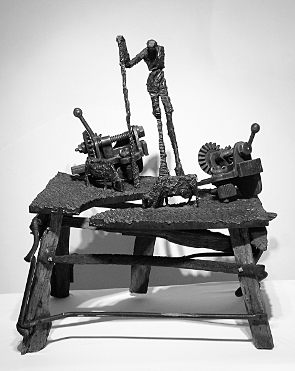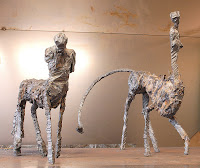E s s a y o n t h e p o l e p l a n t e r , h u n t e r s t h o m p s o n a n d t h e g r a v i t y o f e n s e m b l e s
by T y l e r R. F e n n
'Poleplanter' is an example of me turning myself inside out. An impetus for this exercise, at the time, was the news that Dr. Hunter S. Thompson
had shot himself.
I had recently arrived in Britain from the
Caribbean and like a good Englishman, I went to the pub with companions at 4:15
every day. The pub was a hub, a hive of discussion, deliberation, singing,
rumour, backslapping, riotous laughter, backstabbing and hearsay (all of the
beautifully common and familiar attributes of a small town pub and perfectly
English) Especially on a drizzly day.
Most would leave at around seven for a proper English
meal of fried cod or sausages, mash, and mushy peas. We never did. We ate
bouquets.
I was in a funk with my sculpture. The ideas and
forms that I was self conditioned to making and reworking and reinterpreting
were not transferable to a different place, another country. The animals, the
things, and the environment of Antigua could be carried into the rural blanket
of England, but for me they were no longer relevant. I was making sculpture that was familiar to
me, a bag full of ideas from elsewhere, instead of making work that was
informed by my immediate surroundings and experiences (This is very difficult for an artist; these
abrupt breaks, changes. But I suggest it. Try yourself and your work against
different backdrops. Even the Brits beloved Bacon was lost outside his comfy
London)
So I was making nice sculptures, but man, where
was I?
I was in ancient Greece because that is where
artists go for ideas when they can't walk outside and sketch cows.
It is imperative that an artist applies
pertinence to their art. An imperative of art is to contain pertinence.
Pertinence is an imperative of art.
'centaur and sphinx' England 2006
And then somebody informed me over a picnic
table outside The Vaults that Hunter Thompson shot himself in the head and was
dead
I rebooted, took leave of my companions and the
King Arthur's of Uppingham, "I'm going to go make the most pitiful
sculpture I can" I said.
And I did. I tried. I worked the night in a factory the workers said was haunted and would not be caught there after dark (they weren't keen on day either).
I had set myself the goal of consciously expressing feeling in a
sculpture. I generally make what I see, and let my 'inner' come out through the
process of creating. This time I reversed it, and purposefully pursued
building emotion.
The sculpture that's called hunter, or 'fledgling minotaur' (it
remains untitled) was the first result of this. It was modeled in one
long night and, though my curiosity was somewhat piqued by the
sculpture, it wasn't...enough. What I
wanted to show was of no importance, what I couldn't help but show was
what materialized. The 'fledgling minotaur' is a mature figure,
exhausted maybe, but certainly surefooted.
As a sculptor, you study your object carefully (both the object in front of you, and the object of your endeavor) but also you concentrate
equally as carefully at the space that the object encompasses.
The negative space of the fledgling minotaur is an
irregular polygon or a trapezoid, in fact it's almost a perfect
parallelogram and therefore quite stable, unchanging and tranquil.
The Staff. The Stick. The Pen.
Hunter Thompson was a personally damaged man, no different to most. He
utilized crutches to compensate. His attire, his sunglasses, his
cigarette extension, his guns, his booze...all crutches. But his biggest
and best crutch was his typer, his pen. His pen is what propped him and
allowed him to share himself; and he threw his pen into his field of
journalism like a lance. The third leg of a staff, though an easy gadget to get a two legged sculpture to stand up, took on more importance because of these considerations in these two sculptures (it is also my own personal nod toward Moses...a real Moses that I knew in Antigua, but that's another story)
So the Poleplanter was my second attempt at forming the hopelessness and
exasperation and dismay at hearing of Hunter's suicide into a
sculpture.
The Poleplanter is not a portrayal of Hunter
Thompson. It is an abstract that came from my psyche after hearing the
news of his suicide, which just so happened, in its timing, to amplify
already exasperated feelings.
I made it, or more precisely, 'sketched it out', over the second and
third nights, when the pounding of stamping machines, the gawking of
employees and the glare of naked poster girls were drowned by dark. The
sculpture inherited from its predecessor, in its form, the abdomen. The
severe cut that crosses the gut of 'fledgling minotaur' is more severe in Poleplanter. In fact, the guts of
Poleplanter are completely carved out. But unlike the first sculpture, the second thrusts at the viewer a scalene triangle, the severe change of the delta.
'fledgling minotaur' England 2006
'poleplanter' England 2006
Poleplanter is not my title, it is the description that my friend Glen
gave to it early on...it stuck. His naming of the sculpture reminds me
of somebody staking a claim or planting a flag, which actually portrays confidence and is completely opposite to the intended
attitude. I could consider the sculpture a failure in this
respect. It doesn't completely portray exasperation, or dismay, in
fact, quite possibly the opposite. The figure, though crumpled, is still
on its feet. (versus being on its knees which is a common cliche that
artists lean upon to express woe)
It is the hero in Jean Giorno's novel 'The Man Who Planted Trees'. This is one of the wonderful things about art.
The Poleplanter is 26 by 26 by 73cm tall and weighs about 20 kilos. I've been told that it would take a strong room to hold it. Great compliment.
I've also been reprimanded over it; My friend Scrimmy in Antigua, after seeing photos of it, chastised me;
'You need to make that figure stand up!'...which I subsequently did.
'standing figure' England 2006
I like the Poleplanter and I like that others like it, or at least respond
to it. This is very important to an artist and anyone who tells you
different is a liar. The Importance of Poleplanter, for me, was that it
broke a chain tethering me to my past, and allowed me to go on
investigating my work with a different attitude, a freeness. I was able,
after this piece, to go on and make what I consider to be seminal
pieces. Work that speaks to the industrial and ancient past of Britain. For example, these two little guys; I refer to them as monolith tablets, and call them 'miniliths' (think Telford, think Stonehenge)
Miniliths' hand and band saw cut steel, palm sized, England 2006
The Poleplanter reignited within me a childlike fascination with my
medium.
What did Nietzsche say? Something about how the goal of an adult
should be to achieve the seriousness of a child at play?
Now:
What was once the 'hunter' has become the shepherd.
While renovating my cottage over the last couple of years I have been living with my sculpture; staring at it, moving it, reconsidering it, re-purposing it (through necessity or through play) and many pieces that were once individual sculptures have gravitated towards others over time and are now part of ensembles. The 'fledgling minotaur' finally found its place amongst the field, the fold.

A most important thing about art for an artist one that any artist would do well to keep in mind
Is that one can be (and should be) terribly impressed by the work of others, but it is one's own work that truly teaches
Picasso always stressed when asked that it was his own work that informed his next
Now back to Hunter S. Thompson, look at the result of his actions
Elevated above the cows and grinding gears, stabbing a lance into the land of Woody Creek
And the Poleplanter?
Burying seeds in the gray matter of my attic.
'the pastoral' Wales 2013 view as triptych
tylerrfenn 2007/2013
b a c k
